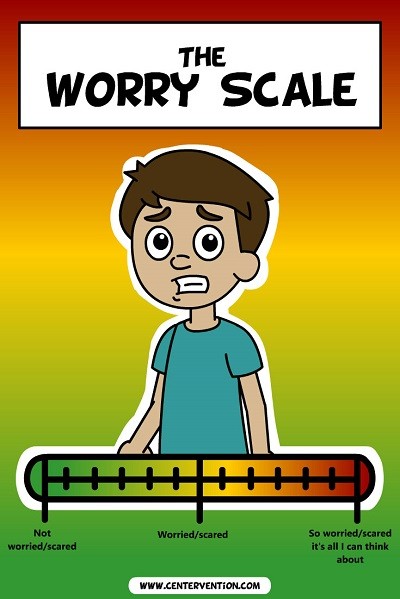There are a lot of heavy things happening that cause students to feel worried, fearful, and anxious. And while our first instinct may be to shelter our students, pretending that worries and fears don’t exist is the opposite of what we should be doing. In fact, encouraging kids to talk about what’s frightening them and validating them, helps tremendously.
In this lesson, you’ll help students understand how fear works, that it’s okay to be afraid, and how to not let fears control how they live.
Students will identify things that cause them to worry or fear and work through them by deciding where they belong on a “worry scale.”

Recommended Grade Level: Elementary and Middle
SEL Skill(s): Emotion Regulation, Impulse Control
Duration: 30 minutes
Materials:
- Worry Scale Worksheet (Available when logged in to your Centervention Educator account)
Worry Scale Lesson Instructions
Prompt: “Who here has ever been scared?
We all have things that scare us, and that’s OK. And there are a lot of things happening in the world today that can make us worry to the point of being afraid, and that is called fear. Can anyone explain what fear is?
* give time for students to answer *
Fear can sneak up on you and make you feel weird – your heart might race and you might get a frog in the back of your throat or your stomach might feel funny or nervous.
Sometimes fear can completely make us feel like we can’t do anything.”
* Hand out worksheet *
Prompt: “I’d like for you to look at the worksheet I just gave you. Please write down a few things that scare you or that you worry about.
After you’ve written down a few things, look at the scale below. For each thing you listed, think about where it belongs on the scale.
For example: If I wrote down that bugs scare me, I’d look at the scale, and it would fall on “little worried/scared” because they scare me but not so much where I’m really scared.”
* Give students time to work *
Prompt: “Now that we’ve written down our worries or the things that scare us and thought about where they fall on the scale, let’s talk about them together.”
* Draw the same scale on your board *
Ask students to share some of their fears with the class if they are comfortable doing that.
Explain that one student may be very fearful about something that another student isn’t fearful of at all. And explain how helpful it can be to talk about our fears. Parents, teachers and friends are here to talk about it with you. By talking about what we’re fearful of, making a plan to help with that fear or move past it, will make us feel better. It will also help us either overcome the fear, or it will move down that worry scale for us.
Additional Resources
Books
- Wilma Jean – The Worry Machine by Julia Cook
- Not-So-Brave Penguin by Steve Smallman
- Worry Says What? by Allison Edwards
- Saturday Is Swimming Day by Hyewon Yum
- Talk About The Monster by Mistofer Christopher
- When I Feel Scared by Cornelia Maude Spelman
Related Lessons